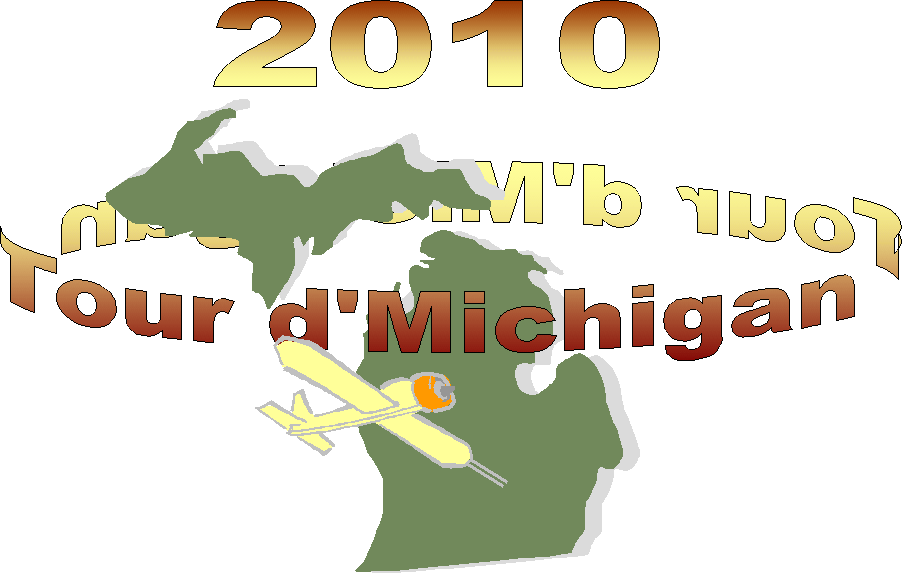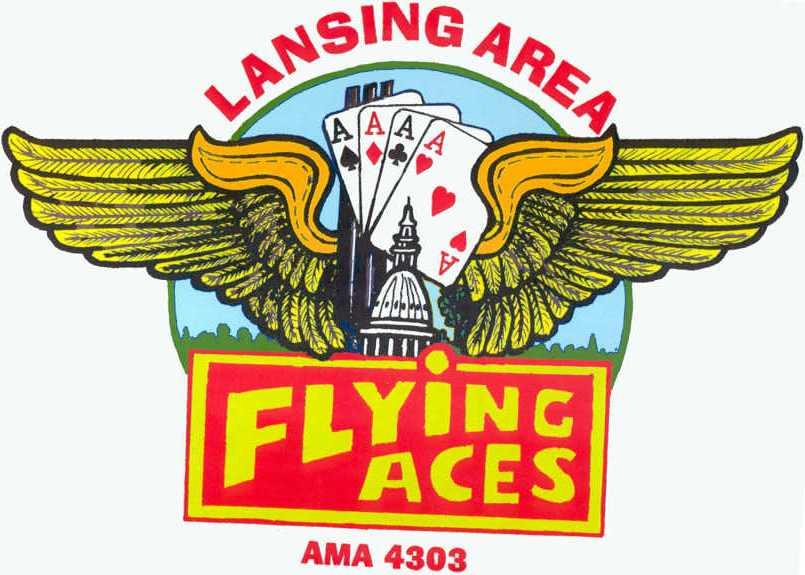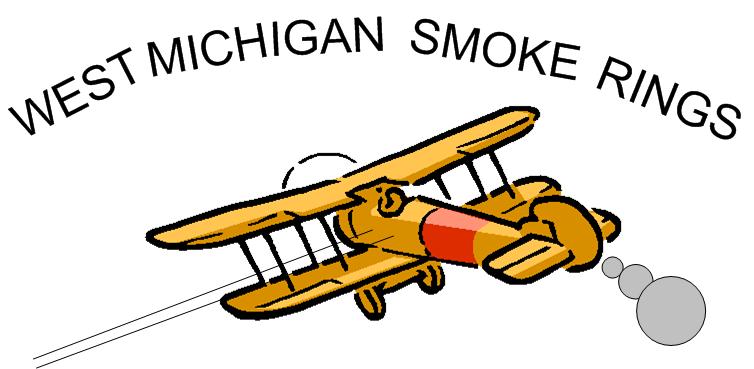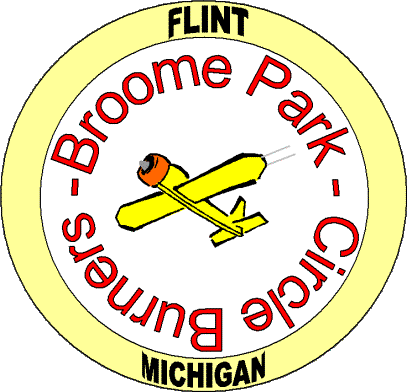- Judging will be conducted by a 3 member panel designated by the Contest Director at each venue
- The ONLY judging will take place prior to the start of the first flying event
- Aircraft receiving the most points wins
- Winning aircraft MUST fly in an event - no hangar queens! If the aircraft with the most votes does not fly in an event, the next highest vote total will win
- Borrowed or Purchased ready-To-Fly planes are ineligible
- Every plane a contestant enters and flies will be eligible for appearance points, but only one award per pilot per venue. If a single pilot’s planes score two (or more) highest totals, pilots with the next highest scores will be awarded the succeeding placements
- Scoring based on the following system:
- Points (1 through 5 are awarded based on the following scale)
- 1 Point: Butt ugly, but flies (the airplane, not the pilot)
- 2 points: Run down - Looks like an attempt at an airplane, but may be poorly assembled or has been poorly maintained
- 3 points: Looks decent - may have a few miscues in part assembly, paint masking, or keeping the covering down, or appears unattractive (good finish-just not very appealing)
- 4 Points: Pretty good looking airplane - well maintained and is appealing to the eye
- 5 Points: Beautiful airplane - appropriate finish. Something you would use to draw in the stunt groupies and inspire the masses
- Multiplier (The following multiplier is applied to points awarded)
- 2 for ARF
- 4 for ARC
- 6 for kit or plan built by pilot
- Score = Points x Multiplier
- This system allows point ranges as follows: 2-10 for ARF, 4 to 20 for ARC and 6 to 30 for built up models. This system is designed to encourage model building with a second emphasis on finishing and maintenance. Although built-up models are encouraged, a clean, well assembled and cared for ARF could still place better than a poorly built and maintained built up model.
(Back to Top)
Event Rules
Fun Stunt
- Fliers will be required to fly the complete stunt pattern in one flight
- Take Off and Level Flight - 4 Laps (0 - 10 Points)
- Climb and Dive - 2 Consecutive (0 - 10 Points)
- Wingovers - 2 Consecutive (0 - 10 Points)
- High and Level - 4 Full Laps (0 - 10 Points)
- One Inside Loop (0 - 10 Points)
- Roller Coaster - 2 Laps (0 - 10 Points)
- Optional - Loop, Figure 8, or Inverted Flight (0 - 10 Points)
- Landing (0 - 10 Points)
Stunt Pattern
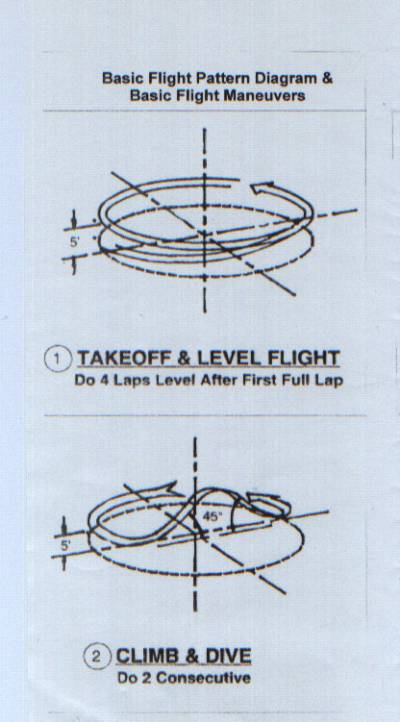
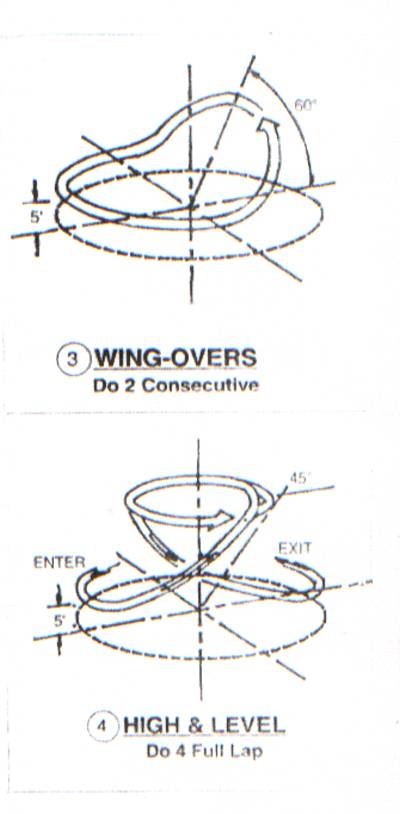
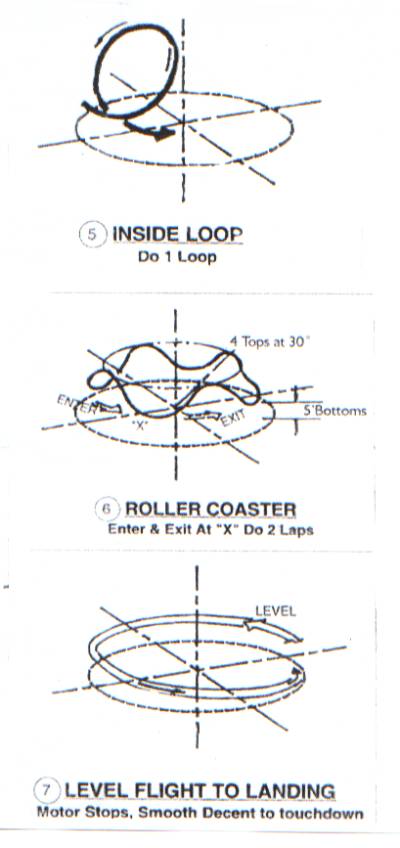
.35 Rat Race
- Each flier will designate a person to time their run
- Pit crew allowed to start/re-start flier's engine
- All engines will be running and aircraft released simultaneously to begin each race
- Winner is the flier having the shortest time for flying 100 full laps
- In the event of a tie, a fly-off will be used to break the tie
- Races will consist of 2 to 3 aircraft depending on the number of entries - no solo flights
- Aircraft will maintain a racing altitude of 10 - 15 feet
- A temporary altitude of 25 feet is permitted for passing
- One warning will be given for the first altitude violation
- Second altitude violation will result in disqualification
- Aircraft can be hand launched or ROG
- Engines limited to .35 displacement
- Plain bearings
- UNMODIFIED (except for needle valve / valve body replacement)
- Suction fuel systems only
- Mufflers are optional but encouraged
- One pit stop is required per race
- Start window is 30 seconds ~ first horn begins prop flipping ~ second horn (30 seconds later) signals plane launch
- Late starters can still launch when engine fires
Balloon Bust
- Targets will consist of helium filled balloons supported on 1/4 inch square balsa sticks
- Points will be awarded for busted balloons depending on how close they are to the 15 foot tall barrier pole:
- Closest to pole = 25 points
- Points are awarded for broken balloons only. Cutting the balloon free from the supporting stick without breaking the balloon does not score any points
- Fliers have five minutes to break as many balloons as possible. Aircraft can be re-fueled and re-launched within the 5-minute window
- In the event of a tie, a fly-off will be used to break the tie
- Contestants must remain in the center circle for the duration of the flight except for backing up during takeoff and landing to avoid the barrier
- A 25-point bonus for cutting a balloon free on one pass and then breaking it on the next pass (Pilot must remain in pilot’s circle – no chasing! - helium balloons only)
- A 10-point bonus for breaking all balloons in a single flight
- ALTERNATE RULES:
- No tower is used
- 20 Points awarded for each balloon busted within 5 minute time limit
- Elapsed time for breaking all balloons (in seconds) subtracted from balloon total
Combat
- Stock, plain bearing, non-modified.35 size engines only (replacement needle valve assembly allowed)
- Suction fuel systems only, no pressure tanks
- 60 foot lines
- 100 points for each cut on streamer plus one point for each second of air time
- Line cut or knot cut counts for 100 points (no further cuts are allowed on the plane)
- 5 minute match duration
- 5 minute between matches
- Single eliminations
- Most points awarded in match will advance to next round
- Aircraft can be restarted and re-launched during the match providing they are airworthy (as decided by the CD or designee)
- Contestants must remain in the center circle for the duration of the match
- In the event of a tie, a fly-off will be used to break the tie
- Kit style airplanes with landing gear (where applicable) - either be kit built or a scratch of a kit built
- Limit to a 10x6 prop
- Engine MUST BE wired to the bellcrank ~ THIS IS NOT NEGOTIABLE
- If grounded, and you and can repair and get airbore within the 5 minute match time, keep fighting, otherwise, you are eliminated
1/2A Rat Race
- Each flier will designate a person to time their run
- Pit crew allowed to start/re-start flier's engine
- One pit stop is required per race
- All engines will be running and aircraft released simultaneously to begin each race
- Winner will be the flier having the shortest time for flying 50 full laps
- In the event of a tie, a fly-off will be used to break the tie
- Races will consist of 2 to 3 aircraft depending on the number of entries - no solo flights
- Aircraft will maintain a racing altitude of 10 - 15 feet
- A temporary altitude of 25 feet is permitted for passing
- One warning will be given for the first violation
- Second violation will result in disqualification
- Aircraft can be hand launched or ROG
- Allowable engines for the 1/2 A Rat Race:
- Atwood: Wasp .049 and all the .049 Atwoods. This includes the Original/Cadet and those Atwoods with colored heads, integral heads; and the Signature, Atwood Shriek, and Atwood Shriek Signature engines. The Cadet (clear) or earlier Signature (colored) heads may be used on the Shriek, if desired, so as to use standard ¼ x 32 short glow plugs
- Fox: Fox Sport.049 (not the large case/intake F.A.I. model). Glow heads are unrestricted
- Cox: Pee Wee .020, Space Bug Jr., Babe Bee, Golden Bee, Black Widow, and product engines sometimes called the Cox 290. Engines may be 2005 or earlier manufacture. Excluded are the Space Bug, Thermal Hopper, Space Hopper, RR1, TD, Venom, Killer Bee, and Texaco. Parts that fit may be freely interchanged, if desired, between the permitted Cox Engines. Not permitted are any engines, stock or otherwise, that have Killer Bee backplates, or that have TD, Texaco, Killer Bee, or Venom piston sleeve combinations, or other parts from anything other than the permitted engines. Glow heads are unrestricted. MECOA heads for standard glow plugs are permitted
- Holland: Wasp .049 only, not the Hornet
- K&B: K&B Infant, Torpedo .035, Torpedo .049, and SkyFury .049.
- McCoy: Any McCoy .049, either Glow or Diesel. Also includes the plastic case Testors/McCoy engines
- OK Cub: Any OK Cub .049 (or smaller), either Glow or Diesel.
- Spitfire: Baby Spitfire .045, Spitzy .045, and Royal Baby Spitfire .049
- Testors: Copy of Wen Mac Hotshot/AMF Thunderbolt.
- Wen Mac: Any Wen Mac .049, including AMF copies.
- Brodak .049 MK1 - the engine with the blue head
- Engines are to be unmodified, non-pressure fed
100 Lapper
- Any size plane allowed
- One point awarded for each lap up to 100
- One point deducted for each lap over 100
- One pit stop required
- 20 points deducted if run is completed without a pit stop
- 5 minute maximum for pit stops
- Runs can only be terminated by running out of fuel (no dorking, no speed controls)
- Pilot can terminate run at any point within above rules without completing 100 laps
- (Ex: A pilot can complete any number of laps with or without a pit stop if he thinks his points total will be the highest score)
- In the event of a tie, a fly-off will be required to break the tie
Precision Landing
- Any size aircraft may participate
- Aircraft must have landing gear and ROG capability
- Flying circle will be sectioned with points assigned for each section
- Initial take offs will be from the same location
- Aircraft must complete one full lap (pass takeoff point) to score landing points
- Pilot will attempt to land in highest scoring area
- Scoring based on where main gear come to rest
- Wheels on a line score higher point value
- Crashes (as determined by event judge) score no points
- Pilot scoring the most points in 5 minutes wins
- In the event of a tie, a 5 minute fly-off will be used to break the tie
- 10 bonus for landing on each point value at least one time.
Perky Speed Timing
- Engine sizes:
- Glow .14 to .1525
- Diesel .14 to .1525
- Ignition .19 to .23
- Lines:
- Control lines, plus lead outs must be per AMA standards
- Two line control system only
- Line length from center of handle to center of plane 52' 6"
- Intake and Exhaust:
- Suction feed only
- No tuned pipes or performance enhanced exhaust systems
- Construction:
- Model built to plan outline
- Builder must fly and submit times
- Two wheels of at least 1 1/2" diameter required
- Bellcrank mounted to motor mount (Recommended but not a rule)
- Recommended fuel 10% nitro or less
- Flight Procedure:
- 16 laps (one mile) timed
- 3 entries per contestant allowed
- Winner is the closest to the average time
- In case of tie best time under average time wins
- No entry accepted with speeds over 90 mph
- No awards for the highest speeds
Slalom
- Four upright pvc pipes, each with a three foot section painted with caution orange, will be located around the flight circle
- The poles will be placed outside the 60 foot flying circle
- The orange section on each pole will be at a different height
- A 1/4 inch breakable balsa stick will mark the upper and lower boundries of the orange area and will extend toward the center of the circle. The sticks will be long enough to reach to the center of the fuselage
- The sticks are a visual reference for the scorer at each pole to make sure the plane flies at the correct level (between the sticks)
- Each pilot is allowed two minutes to pass through as many gates as possible by flying between the balsa sticks marking the orange section of the pipe.
- One point is scored for each gate successfully flown
- Hitting and breaking a stick eliminates that gate from the rest of the flight and will not longer score any points
- The challenge is the ability to precisely control your airplane in level flight
.15 Racing - Speed Run Division
- Event Purpose: This event is a FUN event intended to encourage craftsmanship in the construction of, and airmanship in the piloting of the aircraft entered in this event. The skill requirements to participate are minimal and the intention is to increase each participant’s skill as the season progresses
- Aircraft Type: Aircraft participating in this event must be representations of actual race planes (Goodyear, Formula 1, Thompson, Golden Age, etc.). Planes built from the Sig Buster or Shoestring kits or built to plans from those kits or provided by the organizers require no documentation. Planes built from other sources require documentation proving that the airplane is a model of an actual racer. The judge/ CD Must be able to recognize that the model looks like the full size airplane. A picture or a three-view would suffice for documentation
- Construction: Solid fuselage and wing. NO lightening holes or similar weight reducing modifications allowed. Cheek cowls, prototype paint schemes, and other scale enhancements are encouraged but not required
- Landing Gear: Two wheels 1 ½ to 2 inches diameter required - no restriction on position
- Engine: Stock Fox 15, K&B Greenhead, or OS LA15. Bronze bushings ONLY. Needle valve and back plate replacement are the only allowable modifications
- Wing Span: Between 24 - 29 inches (Tip to tip)
- Fuselage Length: Between 25 – 27 inches (Spinner to tail)
- Wing Area: 140 square inches minimum
- Controls: Externally mounted bellcrank and controls
- Fuel: Maximum 10% Nitro content
- Fuel Tank: No size restriction, but remenber that runs over 3 minutes are disqualified!
- Propeller: No restriction
- Lines:52 foot .015 lines Handle to aircraft midline MINIMUM LENGTH
- Speed Runs: 16 laps from a running start. Pilot signals start of run. Two timers will time each run with the time/speed being the average of the two. Two attempts per plane per meet, on a rotating basis. Maximum run time is 3 minutes starting from initial release of aircraft. Runs over 3 minutes are disallowed. Lowest time / fastest speed wins
- Safety: Safety glasses are mandatory for all personnel starting engines and launching aircraft. Ear protection is optional but encouraged. The Contest Director may disqualify any contestant or aircraft representing a hazard to themselves or others
- Dispute Resolution: The Contest Director is the final judge for any and all disputes
.15 Racing - Rat Race Division
- Event Purpose: This event is a FUN event intended to provide a step up for pilots who have mastered the Speed Run Division and demonstrate the skill to participate in multi-plane events
- Aircraft Type: Aircraft participating in this event must be representations of actual race planes (Goodyear, Formula 1, Thompson, Golden Age, etc.). Planes built from the Sig Buster or Shoestring kits or built to plans from those kits or provided by the organizers require no documentation. Planes built from other sources require documentation proving that the airplane is a model of an actual racer. The judge/ CD Must be able to recognize that the model looks like the full size airplane. A picture or a three-view would suffice for documentation
- Construction: Solid fuselage and wing. NO lightening holes or similar weight reducing modifications allowed. Cheek cowls, prototype paint schemes, and other scale enhancements are encouraged but not required
- Landing Gear: Two wheels 1 ½ to 2 inches diameter required - no restriction on position
- Engine: Any stock .15 plain bearing engine. Needle valve and back plate replacement are the only allowable modifications
- Wing Span: Between 24 - 29 inches (Tip to tip)
- Fuselage Length: Between 25 – 27 inches (Spinner to tail)
- Wing Area: 140 square inches minimum
- Controls: Externally mounted bellcrank and controls
- Fuel: Maximum 10% Nitro content
- Fuel Tank: No size restriction
- Propeller: No restriction
- Lines: 52 foot .015 lines Handle to aircraft midline MINIMUM LENGTH
- Race procedure: 2 to 3 flyers per race depending on number of entries. Heats consist of 40 laps with 1 required pit stop. Final consists of 80 laps with 2 required pitstops. First plane to complete the required laps and pit stops wins.
- Safety: Safety glasses are mandatory for all personnel starting engines and launching aircraft. Ear protection is optional but encouraged. The Contest Director may disqualify any contestant or aircraft representing a hazard to themselves or others
- Dispute Resolution: The Contest Director is the final judge for any and all disputes
|
(Back to Top)
Awards
|
- The tour will produce winners’ certificates for 1st, 2nd, and 3rd places for each event at each venue. It will be the responsibility of each host club to place the certificates in an appropriate frame or mounting for presentation to the winners.
|
(Back to Top)
Judging
|
- Judges will be designated by the CD at each event
|
(Back to Top)
Fees
- $10.00 for first event and $5.00 for each additional event
- There is no additional fee to participate in Appearance/Craftsmanship but plane must be registered for (and fee paid) for one of competetive events
|
(Back to Top)
Tour Officers
|
- CD for each event:
- Kalamazoo - Leroy Heikes - (269) 685-0083
- Flint – John Paris - (810) 686-5914
- Lansing - Rich Kacmarsky (517) 323-8932
- Tour Board of Directors:
- Leroy Heikes (269) 685-0083
- Rich Kacmarsky (517) 323-8932
- Frank Carlisle (313) 882-8349
- John Paris (810) 686-5914
- Tour Secretary - Rich Kacmarsky
- Tracks event / Tour results
- Maintains Web Site
- Produces / distributes communications
|
(Back to Top)
Directions
KALAMAZOO
The Air Zoo is off I-94 Exit 78, 1 mile South on Portage Road, just past Milham Road. Look for Air Zoo Entrance on left. (East side of Portage Road). Signs will direct you to the site.
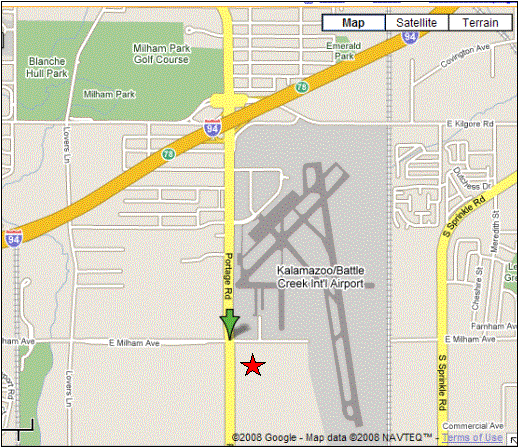
|
FLINT
From Rt. 69 - Exit at Hammerberg Rd and turn South. Turn right (West) on to 12th St./Ballenger Hwy and go to next traffic light. Turn left (South) on to Van Slyke and go to next traffic light. Turn left (East) on to Atherton Rd. and go to next traffic light. Turn left back on to Hammerberg Rd. and drive to parking lot. Generally we find a spot in the fence to drive across the field to the circle.
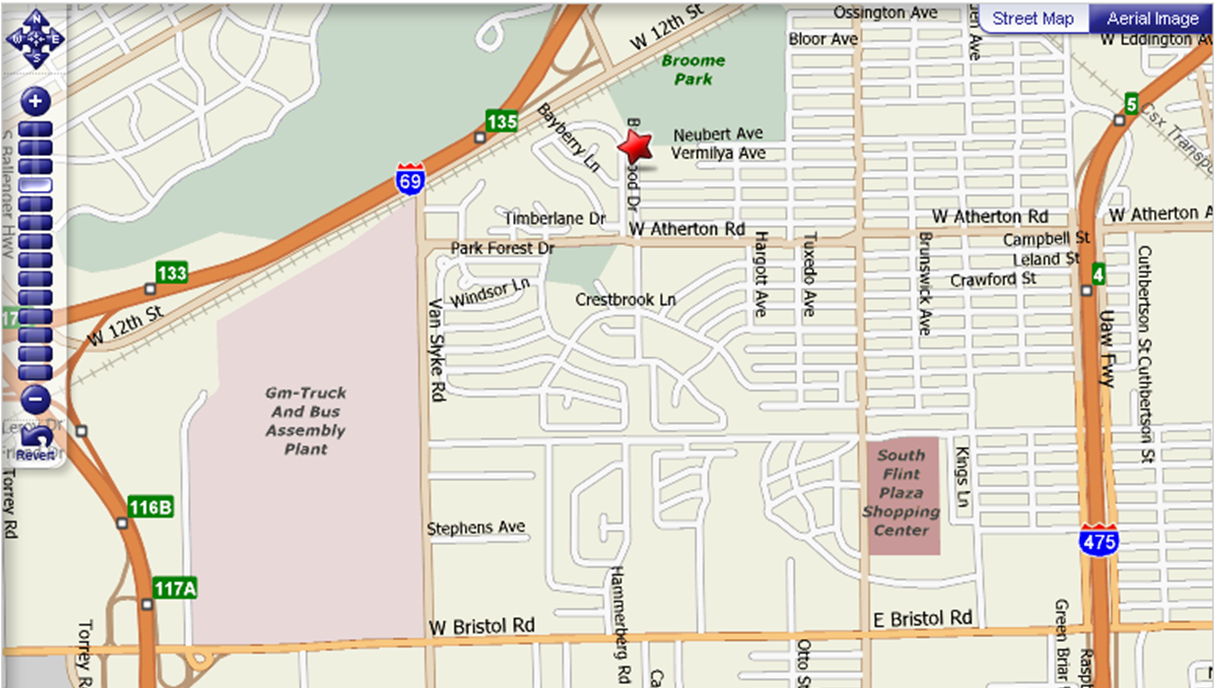
|
LANSING
Erickson Park is located 3-1/2 miles south of Saginaw Highway on Canal Road
in Delta Township. Signs will be posted along all major route to mark the way.
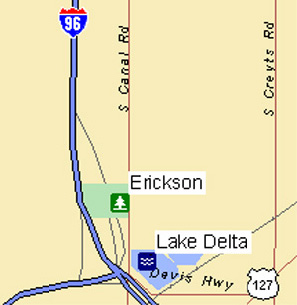 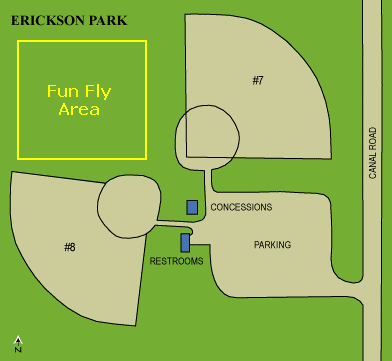
|
(Back to Top)
Home
(Edited by: Rich Kacmarsky - February 2010)
|
